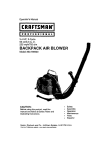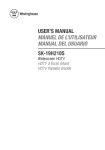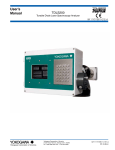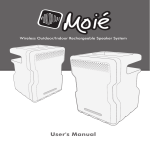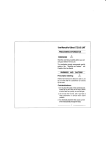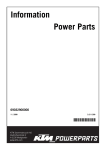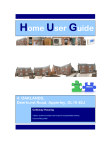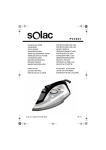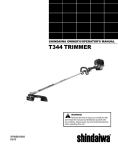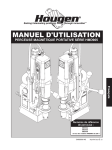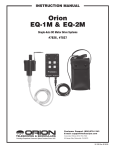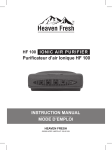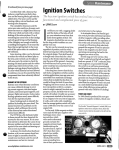Download engineering studies - School Curriculum and Standards Authority
Transcript
Western Australian Certificate of Education Examination, 2012 Question/Answer Booklet ENGINEERING STUDIES Please place your student identification label in this box Stage 3 Student Number: In figures In words Time allowed for this paper Reading time before commencing work: Working time for paper: ten minutes three hours Place a tick in one of the following boxes to indicate your specialist field. Systems and Control Materials required/recommended for this paper To be provided by the supervisor This Question/Answer Booklet Multiple-choice Answer Sheet Document Booklet Data Book To be provided by the candidate Mechanical Electronic/Electrical Number of additional answer booklets used (if applicable): Standard items: pens (blue/black preferred), pencils (including coloured), sharpener, correction tape/fluid, eraser, ruler, highlighters Special items: non-programmable calculators approved for use in the WACE examinations, measuring and drawing instruments Important note to candidates No other items may be taken into the examination room. It is your responsibility to ensure that you do not have any unauthorised notes or other items of a non-personal nature in the examination room. If you have any unauthorised material with you, hand it to the supervisor before reading any further. Copyright © School Curriculum and Standards Authority 2012 Ref: 12-047 ENGINEERING STUDIES 2 STAGE 3 Structure of this paper Section Suggested Number of Number of questions questions to working time available be answered (minutes) Marks available Percentage of exam Section One: Core content Part A: Multiple-choice Part B: Extended answer 10 4 10 3 10 50 10 45 10 25 Section Two: Systems and Control Part A: Multiple-choice Part B: Extended answer 10 4 10 4 10 110 10 105 10 55 Section Two: Mechanical Part A: Multiple-choice Part B: Extended answer 10 4 10 4 10 110 10 105 10 55 Section Two: Electronic/Electrical Part A: Multiple-choice Part B: Extended answer 10 4 10 4 10 110 10 105 10 55 Total 100 Instructions to candidates 1. The rules for the conduct of Western Australian external examinations are detailed in the Year 12 Information Handbook 2012. Sitting this examination implies that you agree to abide by these rules. 2. Answer the questions according to the following instructions. Sections One and Two, Part A: Answer all questions on the separate Multiple-choice Answer Sheet provided. For each question, shade the box to indicate your answer. Use only a blue or black pen to shade the boxes. If you make a mistake, place a cross through that square, then shade your new answer. Do not erase or use correction fluid/tape. Marks will not be deducted for incorrect answers. No marks will be given if more than one answer is completed for any question. Section One, Part B: Write answers in this Question/Answer Booklet. Answer only three (3) questions. Section Two, Part B: You must choose to answer only one (1) of the specialist sections. Write answers in this Question/Answer Booklet. All questions must be answered. 3. You must be careful to confine your responses to the specific questions asked and to follow any instructions that are specific to a particular question. 4. Spare pages are included at the end of this booklet. They can be used for planning your responses and/or as additional space if required to continue an answer. ● Planning: If you use the spare pages for planning, indicate this clearly at the top of the page. ● Continuing an answer: If you need to use the space to continue an answer, indicate in the original answer space where the answer is continued, i.e. give the page number. Fill in the number of the question(s) that you are continuing to answer at the top of the page. 5. The Document Booklet and Data Book are not handed in with your Question/Answer Booklet. See next page CORE CONTENT 3 ENGINEERING STUDIES STAGE 3 Section One: Core content 35% (45 Marks) This section has two (2) parts. Part A: Multiple-choice Answer all questions Part B: Extended answer Answer three (3) questions Suggested working time: 60 minutes. Part A: Multiple-choice 10% (10 Marks) This part has ten (10) questions. Answer all questions on the separate Multiple-choice Answer Sheet provided. For each question shade the box to indicate your answer. Use only a blue or black pen to shade the boxes. If you make a mistake, place a cross through that square then shade your new answer. Do not erase or use correction fluid/tape. Marks will not be deducted for incorrect answers. No marks will be given if more than one answer is completed for any question. Suggested working time: 10 minutes. 1. An engineering drawing of an object would normally have a scale value shown on the drawing in the form, for example, ‘Scale 1:10’. This can be interpreted as the (a) (b) (c) (d) drawing is 10 times larger than the real object. drawing is 10 times smaller than the real object. dimensions shown on the drawing should be multiplied by 10 when manufacturing the object. dimensions shown on the drawing should be divided by 10 when manufacturing the object. 2. The most important aspect of a design solution is its (a)safety. (b)cost. (c)function. (d)marketability. 3. The main purpose of a 3D drawing of an object is to (a) (b) (c) (d) show the true shape of the object. provide a drawing suitable for a machinist to manufacture. provide a good impression of the overall shape of the object. enable dimensions to be added to the drawing. See next page ENGINEERING STUDIES STAGE 3 4 CORE CONTENT 4. A chart used to assist a designer to calculate the total cost for the manufacture of a product made from several component parts should include which columns? (a) (b) (c) (d) item, number required, total cost number required, unit cost item, unit cost, number required and total cost item, total cost 5. The safe working load (SWL) shown in a label on a ladder is intended to indicate the (a) weight of the ladder. (b) maximum weight of the person using the ladder. (c) number of times the ladder can be used before being given a safety inspection. (d) maximum angle at which the ladder can be placed against a wall. 6. 7. 8. Many components used in engineering design have properties that are labelled with a tolerance, e.g. 100 ± 0.1 mm, 100 ± 5 Ω. The value of the tolerance is intended to (a) (b) (c) (d) allow the property to be varied at will in the manufacturing process. allow for practical small variations in the manufacturing process. indicate to the user that a component may not be fit for purpose. require the designer to review the property before manufacturing commences. The selection of the best light bulb for use in your bedside reading lamp should be based primarily on its (a) power consumption. (b) light output. (c) life expectancy. (d)cost. Items of equipment that are used by people are often designed to meet ergonomic requirements. Ergonomics concerns (a) (b) (c) (d) the time taken to perform a task with the equipment. the time it takes the user to become proficient with the use of the equipment. how the use of the equipment may affect the body of the user. the treatment of injuries sustained while using the equipment. See next page CORE CONTENT 9. 5 ENGINEERING STUDIES STAGE 3 A time line for a manufacturing task describes (a) (b) (c) (d) a series of dates by which each stage of the task should be completed. an estimate of the overall time taken to complete the task. the maximum time before starting on the task. an estimate of the expected cost to complete each stage of the task. 10. An item of equipment could be described as being recyclable if (a) it is accepted as waste at the local waste collection depot. (b) it can be sold on to a new owner. (c) all of its components can be reused for some other purpose. (d) all of its components can be reduced to products that can be disposed of in the sewerage system. See next page ENGINEERING STUDIES STAGE 3 6 CORE CONTENT Section One: Core content Part B: Extended answer 25% (45 Marks) This section has four (4) questions. Answer only three (3) questions. Write your answers in the spaces provided. Spare pages are included at the end of this booklet. They can be used for planning your responses and/or as additional space if required to continue an answer. • Planning: If you use the spare pages for planning, indicate this clearly at the top of the page. • Continuing an answer: If you need to use the space to continue an answer, indicate in the original answer space where the answer is continued, i.e. give the page number. Fill in the number of the question(s) that you are continuing to answer at the top of the page. Suggested working time: 50 minutes. Question 11 (15 marks) The following flowchart diagram describes the process required to complete the design for a product to be manufactured. See next page CORE CONTENT 7 ENGINEERING STUDIES STAGE 3 (a) Provide a short description of what is commonly taken to be the meaning of each of these steps in the design process. (6 marks) Design brief: Generate alternatives: Analyse alternatives: Redesign: Evaluate alternatives: Select solution: See next page ENGINEERING STUDIES STAGE 3 (b) 8 CORE CONTENT You have been given the task of designing a new battery powered torch (flashlight) to be used by security guards as they go check on commercial properties during the night. List and describe four (4) requirements that could be used for the design of this torch. (4 marks) One: Two: Three: Four: (c) Having produced a number of alternative designs for the torch and analysed each against the nominated performance criteria, you are now ready to evaluate the alternatives. Describe the process you would recommend for this evaluation so that the best solution is clearly evident. (5 marks) See next page CORE CONTENT CORE CONTENT 9 9 Question 12 ENGINEERING STUDIES STAGE 3 ENGINEERING STUDIES STAGE 3 (15 marks) Question 12 (15 marks) The following diagram shows a 3D view of a traffic barrier module, of the type often seen near roadworks to control the flow of traffic. These traffic barriers are made of a tough impact-resistant plastic and can be filled with water. The following diagram shows a perspective view of a traffic barrier module, of the type often seen near road works to control the flow of traffic. These traffic barriers are made of a tough impact-resistant plastic and can be filled with water. The module weighs 56 kg when empty. There are two 100 mm diameter holes in the top of the barrier module to allow water to be added. The water can be emptied from a drain valve (not shown in this The module hasdrawing). a mass of 56 kg when empty. There are two 100 mm diameter holes in the top of the barrier module to allow water to be added. The water can be emptied from a drain valve (not shown in this drawing). Ignore the thickness of walls in all calculations. See next page See next page ENGINEERING STUDIES STAGE 3 10 CORE CONTENT (a) Calculate the total mass of the module when it is filled with water. (b) On the next page create a top view of the barrier module. Show all dimensions that can be shown on a top view. The grid shown is 200 mm by 200 mm. (5 marks) See next page (6 marks) CORE CONTENT 11 ENGINEERING STUDIES STAGE 3 If you wish to have a second attempt at this item, the grid is repeated at the end of the Question/Answer Booklet. Indicate clearly on this page if you have used the second grid and cancel the working on the drawing on this page. See next page ENGINEERING STUDIES STAGE 3 12 CORE CONTENT (c) Provide an explanation as to why it is useful to have a barrier module that can be filled with water. (2 marks) (d) The water is added to the barrier module from a water tanker truck that has a 100 mm diameter hose that just fits into one of the holes in the top of the module. Explain why a second hole in the top is necessary. (2 marks) See next page CORE CONTENT 13 ENGINEERING STUDIES STAGE 3 Question 13 (15 marks) Solar water heaters have been developed, manufactured and used in Australia since the 1950s. They are recognised as a key part of a sustainable home. A solar water heating system has four basic parts: 1. a collector to absorb thermal energy from sunlight 2. a storage tank to store the collected heat energy in water 3. a circulation system to transfer collected energy from the collector to the tank 4. a booster heater (either electric or gas) to further heat the water if solar radiation is inadequate to ensure sufficient hot water is available on demand. There are economic and environmental benefits of using a solar water heater. By utilising free energy from the Sun, the solar water heating system provides a financial return via reduced hot water energy bills. It also reduces the environmental impact of producing energy, such as the use of fossil fuel, to heat water. The owner of the solar water heater only uses and pays for the boosting energy when there is a lack of solar radiation. These savings help to pay for the extra cost of the solar water heater over its lifetime. The payback time of solar water heating system can be calculated in either economic or energy terms. (a) Suppose the solar water heating system has a collector area of 4 m2 and the average solar power over a clear and sunny day is 500 joules per second per square metre (J s-1 m2). (i) Show that the total energy received by the solar collector over the day from sunrise (6 am) to sunset (6 pm) is 86.4 megajoules (MJ). (4 marks) Convert 86.4 MJ to kilowatt hour (kWh). Show all workings. energy (J) Hint: power (W) = time (s) , and 1 J is equal to 1 W s. (ii) See next page (2 marks) ENGINEERING STUDIES STAGE 3 14 CORE CONTENT (b) Some electric or gas hot water systems are instantaneous and have no storage. They heat the water as it is required. Why must solar hot water systems have a hot water storage tank? (2 marks) (c) Suppose a gas-boosted solar water heater and a corresponding sized electric water heater have the following capital costs and yearly operating costs. Assume both systems have the same lifetimes and maintenance costs. System type Capital cost Yearly operating cost Gas-boosted solar water heater $4800 $60 Electric water heater $1200 $360 (i) Calculate the extra capital cost of the solar water heater. Show all workings. (1 mark) (ii) Calculate the annual savings in the operating cost due to the solar water heater. Show all workings. (1 mark) (iii) Calculate the number of years it will take the solar water heater to pay for itself, i.e. when will the savings equal the extra cost? Show all workings. (2 marks) See next page CORE CONTENT (d) 15 ENGINEERING STUDIES STAGE 3 Consider the following comparison of the operating energy consumption between a solar system and an electric storage water heater over a period of 15 years. Operating energy (kWh) Solar system Electric system 29 252 118 505 The operating energy is the energy required to heat the water. For the solar system, this is the energy required for boosting. The life cycle energy includes both the capital and operating energy, and represents the total energy consumed over the lifetime of the water heating system. The capital energy of the solar system is the energy used to manufacture the solar water heater. This has been estimated to be 3728 kWh. The energy payback time can be calculated as the capital energy divided by the annual energy saving from the solar system compared with the electric system. Calculate the energy payback time in years for the solar water heating system. Show all workings. (3 marks) See next page ENGINEERING STUDIES STAGE 3 16 CORE CONTENT Question 14 (15 marks) Document 1 ‘Extract from the National Code of Practice for the Installation of Electric Drives in Vehicles’ in the Document Booklet should be read in conjunction with this question and used as a primary reference when answering the parts of the question. (a) What are the front and rear impact acceleration limits specified in the standard for the design of battery restraint systems? (2 marks) Front: Rear: (b) What is the purpose of battery restraint limits? (1 mark) (c) A colleague of yours notes that there is no mention in the Code of the reason for the different battery restraint limits. Explain why you think that the limits need to be different. (2 marks) (d) If lithium batteries are used in a vehicle modification, does the battery box have to be vented? Explain your answer. (2 marks) Ventilated box (Yes/No): Explanation: (e) You are advised that the DC voltage for the main traction battery pack in a modification meets the HAZV classification in the Guidelines. What is the minimum possible voltage of the pack to warrant this classification? (1 mark) See next page CORE CONTENT (f) 17 ENGINEERING STUDIES STAGE 3 What colour must the wiring cable be to comply with the Guidelines? (1 mark) (g) Referring to Clause 2.10 of the Guidelines, what could happen if it was possible for the driver to remove the ignition key no matter what position it was in? Explain your answer. (2 marks) Result of action: Explanation: (h) An electric drive system is being fitted to a vehicle that normally has four passenger seats. The owner advises you that they do not want to use the two rear seats after the conversion if it means that more batteries can be installed in the vehicle to increase the range. You note that the approved loaded weight for the unmodified vehicle would have been based on four passengers and their luggage. Assuming that the batteries each weigh 6 kg, calculate how many could be fitted in place of the rear passengers and their luggage allowances. Show all workings. (4 marks) End of Section One See next page ENGINEERING STUDIES 18 STAGE 3 Section Two: Specialist fields 65% (115 Marks) Candidates are required to choose one of the following options, according to which specialist field they studied in 2012. Tick one of the boxes below to indicate your choice of option. Question numbers Pages Systems and Control 15−28 19−39 Mechanical 29−42 41−57 Electronic/Electrical 43−56 59−78 Specialist field Now turn to the relevant pages and answer the questions for the specialist field you have selected. See next page SYSTEMS AND CONTROL 19 ENGINEERING STUDIES STAGE 3 Section Two: Specialist field—Systems and Control 65% (115 Marks) This section has two (2) parts. Answer all questions Part A: Multiple-choice Part B: Extended answer Answer all questions Suggested working time: 120 minutes. Part A: Multiple-choice 10% (10 Marks) This part has ten (10) questions. Answer all questions on the separate Multiple-choice Answer Sheet provided. For each question, shade the box to indicate your answer. Use only a blue or black pen to shade the boxes. If you make a mistake, place a cross through that square, then shade your new answer. Do not erase or use correction fluid/tape. Marks will not be deducted for incorrect answers. No marks will be given if more than one answer is completed for any question. Suggested working time: 10 minutes. 15. A logic gate with inputs A and B and output A+B is commonly called a (a) (b) (c) (d) 16. If a typical microprocessor controller is required to drive a 50 mA load from one of its output pins, then it is (a) (b) (c) (d) 17. If the power supply to a microprocessor is switched off then back on, and it has not been programmed to cater for a power interruption, then the (a) (b) (c) (d) XOR gate. NOR gate. NAND gate. NOT gate. only possible if none of the other outputs on the device are in use. always possible regardless of the number of other outputs in use. not possible to source or sink such a load current. only possible if the microprocessor supply voltage is doubled. program resumes at the last instruction being executed before the power was switched off. processor restarts the program at the first instruction. microprocessor must be reprogrammed because its ROM has been erased. result is unpredictable. See next page ENGINEERING STUDIES STAGE 3 20 SYSTEMS AND CONTROL 18. In a rack and pinion gear system, if the pinion gear has a circumference of 12 cm and the length of the rack is 288 cm, how far will the rack move if the pinion is rotated 5 times? (a) (b) (c) (d) 19. In a typical vehicle power steering system, the driver turns the steering wheel which in turn varies the hydraulic pressure applied to the drive of the front wheel rack and pinion steering linkage. The system is an example of a closed loop control system (a) (b) (c) (d) 20. If an AC voltage is applied to a diode, the diode will block 2.4 cm 12 cm 24 cm 60 cm only when the driver is considered to be part of the control loop. only when the driver is not part of the control loop. irrespective of whether the driver is part of the loop. only when the vehicle is in motion. (a) the positive component of the signal. (b) the positive or negative component of the signal, depending on how the diode is wired. (c) the negative component of the signal. (d) neither the positive or negative components of the signal, as its purpose is to smooth the input signal. 21. Capacitors are typically connected between control system inputs and ground to (a) (b) (c) (d) 22. A Proportional Control System would be used in which of the following applications in a typical house? remove unwanted high frequency ‘noise’ voltages. limit the voltage on the input pins. rectify the incoming signal. disable unused inputs. (i) (ii) (iii) (iv) turning on a fan adjusting the temperature of an air conditioner setting the timer in a microwave oven dimming a light (a) (i), (ii), (iv) (b) (ii) and (iv) (c) (ii), (iii) and (iv) (d) (ii) See next page SYSTEMS AND CONTROL 21 ENGINEERING STUDIES STAGE 3 23. The accuracy of the output from an ADC is primarily determined by the (a) (b) (c) (d) number of bits used in the conversion. supply voltage. magnitude and frequency of the input signal. output load. 24. In a Pulse Width Modulation System, which of the following vary with changes to the input signal? (i) (ii) (iii) (iv) the amplitude of the output pulses the frequency of the output pulses the width of the output pulses the energy of the output pulses (a) (i), (ii), (iii) and (iv) (b)only (iii) and (iv) (c)only (iii) (d)only (iv) See next page Part B: Extended answer 55%CONTROL (105 marks) ENGINEERING STUDIES 24 SYSTEMS AND STAGE 3 This section has four (4) questions. Answer all questions. Write your answers in the spaces ENGINEERING STUDIES 22 SYSTEMS AND CONTROL provided. Part B: Extended answer 55% (105 marks) STAGE 3 Spare pages included at the endAnswer of this booklet. They can beyour used for (105 planning This section hasare four (4) questions. all questions. Write answers in theyour spaces Part B: Extended answer 55% Marks) responses and/or as additional space if required to continue an answer. provided. • four Planning: If you useAnswer the spare pages for planning, indicate thisinclearly at the top of the page. This part has (4) questions. all questions. Write your answers the spaces Spare pages are included at the end of this booklet. They can be used for planning your provided. • Continuing an answer: If you need to use the space to continue an answer, indicate in the responses and/or as additional space if required to continue an answer. original answer space where the answer is continued, i.e. give the page number. Fill in the • Planning: the spare pages for planning, this at clearly at of thethe toppage. of the page. number Ifofyou the use question(s) that you are continuingindicate to answer the top Spare pages are included at the end of this booklet. They can be used for planning your • Continuing an answer: If you need to use the space to continue an answer, indicate in the responses and/or as additional space if required to continue an answer. Suggested working time:where 110 the minutes. original answer space answer is continued, i.e. give the page number. Fill in the ● Planning: If you use the spare pages for planning, indicate this clearly at the top of the page. number of the question(s) that you are continuing to answer at the top of the page. ● Continuing an answer: If you need to use the space to continue an answer, indicate in the original answer space answer is continued, i.e. give the page number. Fill in the (25 marks) Suggested working time:the 110 minutes. Question 25 where number of the question that you are continuing to answer at the top of the page. Suggested working time: 110 minutes. You are 25 asked to assist with a project to convert a motor vehicle to electric power drive. The Question (25 marks) vehicle is fitted with an analogue fuel gauge that is to be reused as an indicator showing the state of charge of the batteries. In the original vehicle, this meter was connected to a variable resistance sensor in the fuel tank. The resistance of the sensortovaried from 0 ohms are asked to assist with a project to convert a motor vehicle electric power drive.when Thethe QuestionYou 25 (25 marks) tank was empty 50analogue ohms when was full. vehicle is fitted withtoan fuelit gauge thatThe is toequivalent be reusedcircuit as andiagram indicatorisshowing the state of of the batteries. In the original thiselectric meter power was connected You are asked tocharge assist with a project to convert a motorvehicle, vehicle to drive. Theto a variable resistance sensor in the fuel tank. The resistance of the sensor varied from 0 ohms vehicle is fitted with an analogue fuel gauge that is to be reused as an indicator showing the when the tank was empty to 50 ohms it was full. The equivalent circuit diagram is state of charge of the batteries. In thewhen original vehicle, this meter was connected to a variable resistance sensor in the fuel tank. The resistance of the sensor varied from 0 Ω when the tank Gauge was empty to 50 Ω when it Fuel was full. The equivalent circuit diagram is 12 V Fuel gauge Fuel Gauge 12 V Fuel Tank Contents Sensor Fuel tank Fuel Tank contents Contents sensor Sensor Vehicle Chassis (0V) Vehicle Vehicle chassis Chassis (0V) (0V) You are asked to develop a microprocessor system that will pulse width modulate a switching transistor to vary the resistance and hence thewill average current flowing athrough the fuel gauge. You are asked to develop a microprocessor system that pulse width modulate switching The circuit diagram is: transistor to vary the resistance and hence the average current flowing through the fuel gauge. You are asked The circuit diagram is to develop a microprocessor system that will pulse width modulate a switching transistor to vary the resistance and hence the average current flowing through the fuel gauge. The circuit diagramFuel is: Gauge Fuel gauge Vehicle Vehicle R chassis Fuel Gauge Chassis 12 V (0V) (0V) Vehicle R Chassis 12 V (0V) Switching Switching PWM PWM transistor Transistor Controller controller PWM Controller Switching Transistor See next page See next page See next page SYSTEMS AND CONTROL 23 ENGINEERING STUDIES STAGE 3 (a) Describe how a Pulse Width Modulation (PWM) controller varies the speed of a typical DC electric motor. (3 marks) (b) What is the value of the resistor (R) required to replicate the performance of the fuel tank sensor? You may assume that the switching transistor has zero resistance when turned on. Explain your answer. (3 marks) See next page ENGINEERING STUDIES STAGE 3 24 SYSTEMS AND CONTROL Question 25 (continued) (c) If you opt to use a standard 56 Ω resistor (R) in your design, what is the PWM mark to space ratio for the fuel gauge to read ‘empty’? Explain your answer. Assume the mark condition is a logical one, or high, output from the microprocessor. (3 marks) Mark to space ratio: Explanation: (d) What is the PWM mark to space ratio for the fuel gauge to read ‘half full’? Use the same assumptions as in Part (c) above, and also assume that the resistance of the original fuel tank sensor varied linearly with the volume of fuel. Show all workings. (4 marks) See next page SYSTEMS AND CONTROL 25 ENGINEERING STUDIES STAGE 3 (e) Assuming that the state of charge has been input into the microprocessor and stored as a variable between 0 and 100, create a flow chart that will convert the state of charge value into the required PWM output format. (8 marks) Hint: Assume all mark/space pairs add up to 100 divisions. For example, half charge is 50:50. See next page ENGINEERING STUDIES STAGE 3 26 SYSTEMS AND CONTROL Question 25 (continued) (f) Describe an alternative hardware solution using a servo-motor and any other components you feel are necessary, that could be used in place of the PWM solution. (2 marks) (g) Would you use your alternative solution in preference to the PWM solution? Explain your answer. (2 marks) Use alternative solution? (Yes/No): Explanation: See next page SYSTEMS AND CONTROL 27 ENGINEERING STUDIES STAGE 3 Question 26 (25 marks) Document 2 in the Document Booklet ‘The NMB-MAT Stepper Motor’ should be read in conjunction with this question when answering the parts of the question. (a) List three (3) advantages that a belt drive has over a chain drive. (3 marks) One: Two: Three: (b) Describe one (1) advantage that a chain drive has over a belt drive. See next page (1 mark) ENGINEERING STUDIES STAGE 3 28 SYSTEMS AND CONTROL Question 26 (continued) ENGINEERING STUDIES 30 SYSTEMS AND CONTROL STAGE 3 (c) A worm gear driven by a stepper motor is used in a steering control system for a model boat. The captive nut is directly connected to the steering arm of the rudder. (c) A worm gear driven by a stepper motor is used in a steering control system for a model boat. The captive nut is directly connected to the steering arm of the rudder. Plan view of rudder Plan worm View ofgear Rudder and and Worm Gear control system Rudder Rudder Rudder axle Axle Control System Worm Worm gear Gear Rudder Rudder bearing Bearing Rudder control arm (tiller) Rudder Rudder bearing bearing Stepper Stepper motor Motor Captive nut Side view Side View section Cross section cross through through centrelineof of boat boat centreline Rudder control arm Worm drive and nut Hullof of Hull Boat boat Rudder bearing Rudder axle See next page Rudder SYSTEMS AND CONTROL 29 ENGINEERING STUDIES STAGE 3 (i) The pitch of the thread is 5 mm and the length of the shaft is 100 mm. How far will the drive’s captive nut move if the shaft is rotated 180°? Show all your workings. (2 marks) (ii) If the stepper motor was stepped 20 times to achieve the rotation in (i), what are the degrees/step for the stepper motor? (2 marks) (iii) The torque on the rudder shaft when the boat is travelling at maximum speed and at maximum rate of turn is 1200 × 10-4 N m. If a PM55L-048 Uni-Const Ferrite Plastic Magnet (MSPL) motor is used in the application, what is the maximum frequency (pulses per second) that the stepper motor could be expected to handle? The specifications for the motor are in the Document Booklet. (1 mark) (iv) If an alternative motor was used that was torque limited in this application to a maximum frequency of 250 pulses per second and the shaft rotates 10° each step, how long would it take it take to move the rudder from being centred to full deflection? Assume that the motor is torque limited for the entire period. Show all workings. (7 marks) See next page ENGINEERING STUDIES STAGE 3 30 SYSTEMS AND CONTROL Question 26 (continued) (v)Describe two (2) possible modifications that could be made to reduce the torque load on the motor. Indicate clearly the principle involved in each modification and what the impact would be on the performance of the steering system of each modification. (6 marks) One: Two: (d) The relative humidity (RH) in a marine environment can approach 100%. Is the PM55L-048 motor suitable for this application? Explain your answer. (3 marks) Suitable (Yes/No): Explanation: See next page SYSTEMS AND CONTROL 31 Question 27 ENGINEERING STUDIES STAGE 3 (30 marks) You are asked to build a system to measure the current drain from the batteries in an electrically-powered vehicle. The peak current drain is 1000 A DC. You are given a current sensor that provides a linear voltage output between 0 V (0 A) to 5 V (1000 A). The output of the sensor is to be directly connected to an ADC (Analogue to Digital Converter) input of a microprocessor. You are given the choice of two different microprocessors to use. One device has an 8 bit ADC and the other a 12 bit ADC but costs twice as much. The minimum resolution of the 8 bit ADC is 19 mV and the 12 bit ADC is 1.2 mV. The required resolution is ± 0.5 A. (a) Each ADC outputs 0 when the input voltage is 0 V. Show that the maximum number output by the ADC (associated with the maximum current reading) has to be at least 2000 (decimal) to achieve the specified current resolution. (2 marks) (b) Using the maximum output number in Part (a), show that the resolution required from the ADC is approximately 2.5 mV. Show all workings. (3 marks) See next page ENGINEERING STUDIES STAGE 3 32 SYSTEMS AND CONTROL Question 27 (continued) (c) On the basis of your answer to Part (b), which microprocessor would you use to achieve the resolution required? Explain your answer. (2 marks) Chosen microprocessor: Explanation: (d) A system is to be fitted with a microprocessor based controller that monitors the power being used and shuts it down if pre-set limits are exceeded. The following design requirements have been specified for the monitor: ● The microprocessor is required to drive an LCD display via its serial port, a LED over-current warning indicator and a relay that is used to turn the system on. ● The relay is to be turned on once the microprocessor has been initialised. ● The current is to be sensed once a second and the LCD updated with the new value. ● Should the current reading exceed 1000 A, the LED is to be turned ON. ● Should the current exceed 1200 A for more than a minute, the relay is to be turned off. (i) Construct a flow chart that incorporates these requirements. See next page (9 marks) SYSTEMS AND CONTROL (d) (ii) 33 ENGINEERING STUDIES STAGE 3 Will the monitor cause the system to fail safely under all conditions if the power supply circuit to the microprocessor fails? Assume that the system is safe when it is powered down. Explain your answer. (2 marks) Yes/No: Explanation: (iii) Will the monitor cause the system to fail safely under all conditions when the power supply to the microprocessor device is normal? Identify two (2) fault conditions that support your answer and explain what happens in each of these conditions. Assume that the system is safe when it is powered down. (5 marks) Yes / No: Fault condition one: Explanation: Fault condition two: Explanation: See next page ENGINEERING STUDIES STAGE 3 34 SYSTEMS AND CONTROL Question 27 (continued) (e) How you would interface the relay to the microprocessor? Include a circuit diagram in your answer showing each of the components involved. Describe the purpose of all components except the microprocessor and relays. (5 marks) (f) The over-current warning LED is connected to the microprocessor output pin via a dropping resistor. The voltage on the output pin is 4.5 V in the high (LED On) state. The voltage drop across the LED when it is conducting is 1.2 V. Calculate the value of the dropping resistor such that the current flowing into the microprocessor is limited to 10 mA. Show all workings. (2 marks) See next page SYSTEMS AND CONTROL 35 Question 28 (a) ENGINEERING STUDIES STAGE 3 (25 marks) Show how to construct the following gates using just NAND gates by drawing the correctly connected components. (i) NOT gate Use A to describe the input and ‘Q’ the output, and show clearly what any unused inputs are connected to (logic 1 or 0) to produce the desired result. (2 marks) (ii) OR gate Both A and Not A, and B and Not B are available to be used as inputs as you see fit, and Q is to be used to describe the output. Show clearly what any unused inputs are connected to (logic 1 or 0) to produce the desired result. (2 marks) See next page SYSTEMS AND CONTROL 39 SYSTEMS AND CONTROL 39 ENGINEERING STUDIES STAGE 3 ENGINEERING STUDIES STAGE 3 ENGINEERING STUDIES 36 SYSTEMS AND CONTROL STAGE (b) 3 Complete the truth table for the following circuit. What logic building block does it perform? (b) Complete the truth table for the following circuit. What logic building block does it Question 28 (continued) perform? (3 marks) (b) Complete the truth table for the following circuit. What logic building block does it (3 marks) perform? (3 marks) Input A Input B Input A Input A Output Q Input B Input B Output Q Output Q Logic Block Function:_________________________________________________ Logic block function: Logic Block Function:_________________________________________________ are asked to design a control system will use the heat an engine water (c) (c) YouYou are asked to design a control system that that will use the heat fromfrom an engine water cooling jacket to provide cabin heating in a vehicle when the driver turns on the cooling jacket cabin heating in a a vehicle the that driver heater. (c) to provide You are asked to design controlwhen system willturns use on thethe heat from an engine water heater.of Athe diagram of the proposed system is as follows: A diagram proposed system is as follows. cooling jacket to provide cabin heating in a vehicle when the driver turns on the heater. A diagram of the proposed system is as follows: Cabin Cabin heater Heater on/off On/Off Engine Engine radiator Radiator Cabin Heater On/Off Engine Engine Radiator Engine Cabin Cabin heater Heater T Cabin Heater T Radiator Radiatorin incabin Cabin Radiator Radiator solenoid Solenoidvalve Valve EngineHeat heat Engine Temperature Temperature exchanger Exchanger and and Radiator sensor EngineSensor Heat Water Pump water pump Solenoid Valve Exchanger and Water Pump See next page See next page See next page Temperature Sensor Radiator in Cabin SYSTEMS AND CONTROL 37 ENGINEERING STUDIES STAGE 3 The heat from the cooling jacket water is dissipated through a radiator mounted in the front of the vehicle when the cabin heater is not in use and the cooling water temperature varies with the ambient temperature and the power produced by the engine but usually does not exceed 50°C. The water temperature needed for adequate cabin heating is 80°C. The temperature of the water can be raised by switching off the radiator solenoid but leaving it off will cause the water to boil. The radiator solenoid is to be turned on (output Q = True) whenever: ● the engine is running (Input A = True) and the cabin heater is off (Input B = False) or ● the cabin heater is on (Input B = True) and the water temperature has exceeded 80°C (Input C = True). (i) Construct a logic diagram that shows how these signals can be connected to logic gates to achieve the desired result. Label each signal input according the conventions above and each logic gate with its type. (5 marks) Note: Use only the logic elements described in the Data Book. See next page ENGINEERING STUDIES STAGE 3 38 SYSTEMS AND CONTROL Question 28 (continued) (ii) Construct the truth table for the control of the radiator solenoid. A B C (4 marks) Q (d) In order to reduce the load on the engine cooling system as described in Part (c), you are also requested to provide an interlock so that the heater solenoid is only able to be turned on by the driver when: ● the ambient air temperature outside the vehicle exceeds 40°C; and ● the heater control has been selected and the engine is running. Why is it not necessary to include the engine running as one of the inputs to the logic circuit when the heater is operated? Explain your answer. (3 marks) Why it is not necessary: Explanation: See next page SYSTEMS AND CONTROL 39 ENGINEERING STUDIES STAGE 3 (e) When the control system for the radiator solenoid is built and tested, it is noted that the solenoid valve is switching on and off every couple of seconds when the cabin heater is turned on. This could cause premature failure of the solenoid. (i) Explain why this is happening. (2 marks) (ii) Describe a possible solution to the problem and explain briefly how it would work. (2 marks) Solution: How it works: (iii) Would you use a programmable controller or retain a hardwired design approach? Circle your choice, and explain your answer. (2 marks) Programmable controller Hardwired design Explanation: End of Section Two: Systems and Control See next page ENGINEERING STUDIES 40 This page has been left blank intentionally See next page STAGE 3 MECHANICAL 41 ENGINEERING STUDIES STAGE 3 Section Two: Specialist field—Mechanical 65% (115 Marks) This section has two (2) parts. Part A: Multiple-choice Answer all questions Part B: Extended answer Answer all questions Suggested working time: 120 minutes. Part A: Multiple-choice 10% (10 Marks) This part has ten (10) questions. Answer all questions on the separate Multiple-choice Answer Sheet provided. For each question, shade the box to indicate your answer. Use only a blue or black pen to shade the boxes. If you make a mistake, place a cross through that square, then shade your new answer. Do not erase or use correction fluid/tape. Marks will not be deducted for incorrect answers. No marks will be given if more than one answer is completed for any question. Suggested working time: 10 minutes. 29. A pin jointed truss carries its applied loading by a combination of (a) (b) (c) (d) 30. If an object is moving in a straight line at constant velocity, it can be described as being in a state of (a)acceleration. (b)equilibrium. (c)instability. (d) zero gravity. 31. Compared with structural steel, copper can be described as being (a)stiffer. (b) less dense. (c)stronger. (d) more ductile. 32. In a tensile test of a steel specimen, the amount of energy absorbed by the specimen during the test is found from the (a) (b) (c) (d) bending moments. shear forces. axial forces. gravity forces. area under the load-extension graph. area under the stress-strain graph. total force multiplied by the total extension. maximum stress divided by the maximum strain. See next page ENGINEERING STUDIES STAGE 3 42 MECHANICAL 33. A uniformly distributed load placed on a beam is best described as a force that (a) (b) (c) (d) 34. The SI unit used to describe energy is the joule. An alternative is (a)newton-metre. (b) newton per metre. (c) watt per metre. (d)watt. 35. If the factor of safety for the design of steel bolts is 1.5, and it is known that a 10 mm diameter bolt will fail at a load of 100 kN, you would expect the diameter of a bolt to safely carry 100 kN will be at least (a) (b) (c) (d) is applied at regular intervals along the beam. results only from the self weight of the beam. is applied uniformly along a part of the beam. is applied at the mid and quarter points of the span of the beam. 15.2 mm. 14.1 mm. 12.2 mm. 11.4 mm. 36. The units of stress for a member of a structure with a tensile force in it are MECHANICAL 45 ENGINEERING STUDIES STAGE 3 (a) kg m-2. (b) kg m2 s-2. (c)kg2 m s. (d) kg m-1 s-2. 37. The following diagram shows a force (F) acting on a rectangular object. 37. The following diagram shows a force (F) acting on a rectangular object. F c P b a The Themoment momentofofthe theforce forceFFabout aboutaapoint pointPPisisbest bestdescribed describedby by: a. (a) b. (b) c. (c) (d) d. F *Fa× a. F *Fb× b. F *Fc× c. × (a+b). F *F(a+b) See nextwith page 38. If a ball with mass of 1 kg is thrown upwards an initial velocity of 10 ms-1 to a height of 20 m before falling back to earth, its potential energy when at its highest point is close to: MECHANICAL 43 ENGINEERING STUDIES STAGE 3 38. If a ball with mass of 0.1 kg is thrown upward and reaches a height of 20 m above ground before falling back to the ground, its potential energy when at its highest point is closest to (a) (b) (c) (d) 19.6 J. 30.4 J. 50.0 J. 69.6 J. See next page ENGINEERING STUDIES ENGINEERING STUDIES STAGE 3 3 STAGE 4446 MECHANICAL MECHANICAL Part Part B: Extended answer B: Extended answer 55% 55%(105 (105Marks) Marks) (4) questions. Answer all questions. Write answers in the spaces This This part part has has fourfour (4) questions. Answer all questions. Write youryour answers in the spaces provided. provided. Spare pages included at the of this booklet. They can usedfor forplanning planningyour your Spare pages are are included at the endend of this booklet. They can bebeused responses and/or as additional space if required to continue an answer. responses and/or as additional space if required to continue an answer. • Planning: If you spare pages planning,indicate indicatethis thisclearly clearly at at the the top top of ● Planning: If you useuse the the spare pages forfor planning, of the the page. page. • Continuing an answer: If you need to use the space to continue an answer, indicate in the ● Continuing an answer: If you need to use the space to continue an answer, indicate in the original answer space where the answer is continued, i.e. give the page number. Fill in the original answer space where the answer is continued, i.e. give the page number. Fill in the number of the question(s) that you are continuing to answer at the top of the page. number of the question that you are continuing to answer at the top of the page. Suggested working time: 110 minutes. Suggested working time: 110 minutes. Question 39 Question 39 (25 marks) (25 marks) The following diagram a and ropepulley and pulley system for unloading boxes a truck The diagram below shows show a rope system for unloading boxes fromfrom a truck andand placing them on the ground where they can be unpacked. The top pulley-block is attached to placing them on the ground for unpacking. The top pulley-block is attached to the end of a beam the end of a beam that is supported at one end on the wall of the factory unit and by a tie rod at that is supported at one end on the wall of the factory unit and by a tie rod at the other end. the other end. 2.0 m Tie 30º Beam 30º F 200 kg See next page See next page MECHANICAL 45 ENGINEERING STUDIES STAGE 3 The operator pulls the rope with a force F and at an angle of 30° to the vertical to lift a box off the back of the truck. The truck then moves forward so the operator can lower the box to the ground. The beam weighs 100 kg and you can ignore the weight of the tie and the rope-pulley system. (a) If the mass of the box is 200 kg, show that the force (F) required to lift it is approximately 490 N. Show all workings. (2 marks) (b) When the load of 200 kg is being lifted, show that the forces caused by the pulley system acting on the end of the beam where the pulley system is attached are: ● ● Vertical force - close to 2384 N Horizontal force - close to 245 N. Show all workings. (8 marks) See next page ENGINEERING STUDIES STAGE 3 46 MECHANICAL Question 39 (continued) (c) On the diagram below of the beam, draw a schematic representation of the forces resulting from all the applied loads and reactions. Point A is the left-hand end of the beam, C is the right hand end, and B is the mid-point of the beam. Show each force as ENGINEERING an arrow, clearly indicating its direction, and value or a STUDIES 48 label each force with its knownMECHANICAL STAGE blank (5 marks) 3 if its value is currently unknown. (c) Draw on the following diagram of the beam a schematic representation of the forces resulting from all the applied loads and reactions. Point A is the left hand end of the beam, C is the right hand end, and B is the mid-point of the beam. Show each force as an arrow clearly indicating its direction and label each force with its known value or a label if its value is currently unknown. (5 marks) A (d) B C Show that the force in the tie rod is close to 5748 N. (4 marks) _________________________________________________________________________ _________________________________________________________________________ (d) Show that the force in the tie rod is close to 5748 N. (4 marks) _________________________________________________________________________ _________________________________________________________________________ _________________________________________________________________________ _________________________________________________________________________ _________________________________________________________________________ See next page MECHANICAL (e) 47 ENGINEERING STUDIES STAGE 3 Calculate the magnitude of the vertical and horizontal components of the reaction force at the left-hand end of the beam, i.e. at Point A. Show all workings. (6 marks) See next page ENGINEERING STUDIES STAGE 3 ENGINEERING STUDIES STAGE 3 Question 40 50 MECHANICAL 48 MECHANICAL (25 marks) Question 40 (25 marks) The following diagram shows a cross section and a partial elevation of a cantilevered balcony. The The diagram below shows a cross-section and a partial elevation of aon cantilevered balcony. balcony is intended to support a number of people standing it. The main beamsThe are balcony is intended to the support the weight number of people standing on it. The main the beams cantilevered from wall and spacedofata2.0 m intervals. Four cross beams support are cantilevered and spaced at 2.0 m intervals. Four cross beams support the decking that from is 50the mmwall thick. decking, which is 50 mm thick. Decking Cross Beam Cantilever Beam 2.0 m 3.0m Elevation Elevation Cross Section Cross-section The material and loading properties are: The material and loading properties are: Item Component Cantilever Beam Cantilever beam Cross Beam Cross beam -3 900 kg m-3 900 kgm Decking Decking People Weight/Load Weight/Load 200 kgm-1 200 kg m-1 -1 50 kgm 50 kg m-1 500 kg m-2 500 kgm-2 People You can assume that each cantilevered beam carries the loads from a 2.0 m length of balcony. Also, each cross beam carries a share of the loads imposed from the decking, and the people For the design you can assume that each cantilevered beam carries the loads from a 2.0 m standing on the balcony, from that part of the decking equidistant from each adjacent cross length of balcony. Also, each cross beam carries a share of the loads imposed from the beam. decking, and the people standing on the balcony, from that part of the decking equidistance from each adjacent cross beam. (a) Show that the load imposed on the balcony by the people and the weight of the decking (a)is about Show thatNthe load themarks) decking 5341 m-2-2 . imposed on the balcony by the people and the weight of (3 is it is about 5341 Nm (3 marks) _________________________________________________________________________ _________________________________________________________________________ _________________________________________________________________________ _________________________________________________________________________ _________________________________________________________________________ _________________________________________________________________________ _________________________________________________________________________ _________________________________________________________________________ _________________________________________________________________________ See next page See next page MECHANICAL 51 MECHANICAL 49 ENGINEERING STUDIES STAGE 3 ENGINEERING STUDIES STAGE 3 (b) Show that the loads imposed by the four cross beams (that support the decking and the peopleShow on the balcony) on imposed the cantilever are approximately as follows: (b) that the loads by thebeam four cross beams that support the decking and the people on the balcony on the cantilever beam are approximately as follows. (5 marks) 11 662 N 662 NN 11662 N 11 11662 6321 N 6321 N (5 marks) _________________________________________________________________________ _________________________________________________________________________ _________________________________________________________________________ _________________________________________________________________________ _________________________________________________________________________ _________________________________________________________________________ _________________________________________________________________________ _________________________________________________________________________ _________________________________________________________________________ See next page See next page ENGINEERING STUDIES STAGE 3 ENGINEERING STUDIES Question 40 (continued) STAGE 3 50 52 MECHANICAL MECHANICAL (c) Sketch the shear force and bending moment diagrams for the cantilever beam on the following axes. Calculate the key numeric values to fully define the shape of the (c) diagrams on themoment diagrams. (17on marks) Sketchand the show shearthese force values and bending diagrams for the cantilever beam the following axes. Calculate the key numeric values to fully define the shape of the diagrams and show these values on the diagrams. (17 marks) SF BM See next page See next page MECHANICAL MECHANICAL 53 51 Question 41 Question 41 MECHANICAL ENGINEERING STUDIES ENGINEERING STUDIES STAGE 3 STAGE 3 (25 marks) (25 marks) ENGINEERING STUDIES STAGE 3 The diagram below shows a schematic representation of a railway wagon on a track Question (25 marks) approaching an41 energy absorbing buffer stop. The following diagram show a schematic representation of a railway wagon on a track approaching an energy absorbing buffer stop. 53 The following diagram show a schematic representation of a railway wagon on a track approaching an energy absorbing buffer stop. The railway wagon weighs 5000 kg when fully loaded and is potentially moving at up to 20 kph. The railway 5000onkgthe when fullyfail loaded and isstop potentially moving at up to to rest The idea iswagon that if weighs the brakes wagon the buffer will bring the wagon If the brakes on the wagon fail, the buffer stop is intended to bring the wagon to rest 20without km h–1.any major damage. without any major damage. The railway weighs 5000 kg when fullyram loaded is potentially moving at up to 20 The buffer stopwagon is made up from a compressible withand a very large spring all contained in akph. large The ram linearlyfail elastic response to an imposed force.toThe Theblock ideaof is concrete. that if the brakes onhas theawagon the buffer stop will bring the wagon rest The buffer stop up of a compressible ram with a very large spring contained in a large characteristics ofmade the damage. ram are like this: without anyismajor block of concrete. The ram has a linearly elastic response to an imposed force. The The bufferofstop made a compressible ram with a very large spring all contained in a characteristics theisram are up as from shown in the graph below: Force The ram has a linearly elastic response to an imposed force. The large block of concrete. characteristics of the ram are like this: Force 250 kN Force (kN) 250250 kN 500 mm Change in length where the Change in Length (the horizontal axis) is a measure of how much the ram moves, 500mm and Force (the vertical axis) is the force required to make500 the movement.Change The slope of this length graph is called the stiffness of the ram. You can assume that the buffer in stop is heavy enough Change in length (mm) that it will not move when impacted by the wagon. where the Change in Length (the horizontal axis) is a measure of how much the ram moves, and Force (the vertical axis) is the force required to make the movement. The slope of this The change lengththe (horizontal axis) a measure ofassume how much moves force enough graph isincalled stiffness of theisram. You can thatthe theram buffer stopand is heavy (vertical themove forcewhen required to make The slope of this graph is called the thataxis) it willisnot impacted by the the movement. wagon. stiffness of the ram. You can assume that the buffer stop is heavy enough not to move when struck by the wagon. See next page See next page See next page ENGINEERING STUDIES STAGE 3 52 MECHANICAL Question 41 (continued) (a) Explain the difference between potential and kinetic energy, and describe the changes in these energy types you would expect to occur when the wagon hits the buffer stop. (5 marks) Potential energy: Kinetic energy: Changes: (b) Show that the kinetic energy contained in the wagon when it is moving at 20 km h–1 is close to 77 160 N m. (3 marks) See next page MECHANICAL 53 ENGINEERING STUDIES STAGE 3 (c) When the wagon hits the ram, the spring contracts and the wagon gradually comes to a stop. Show that the ram will contract about 0.55 m before the wagon comes to a stop. (6 marks) (d) Show that the average de-acceleration imposed on the wagon is about 27.8 m s-2 while it is coming to rest. (4 marks) (e) Calculate the time taken for the wagon to come to rest after it first contacts the buffer ram. (4 marks) See next page ENGINEERING STUDIES STAGE 3 54 MECHANICAL Question 41 (continued) (f) Explain where all the kinetic energy has gone once the wagon has come to rest. (3 marks) See next page MECHANICAL 55 Question 42 ENGINEERING STUDIES STAGE 3 (30 marks) This question should be answered with reference to Document 3 ‘Stainless Steel’ in the Document Booklet. Stainless steel is a particular type of steel. Answer the following questions relating to the properties and uses of stainless steel. (a)Describe two (2) properties of stainless steel that make it suitable for use in external environments. (2 marks) One: Two: (b) Stainless steel is an alloy of steel with which additional element? What is the approximate percentage of that element by mass? (2 marks) Element: Percentage by mass: (c) When was it reported in the press that stainless steel was invented, and for what use? (2 marks) When: Use: (d) Complete the following sentences. To be protective, the corrosion layer must be Most normal ironwork corrodes because it develops a It was known as early as 1821 that iron-chromium alloys were corrosion resistant, but they were not useful because See next page (3 marks) ENGINEERING STUDIES STAGE 3 56 MECHANICAL Question 42 (continued) (e) In harsh environments what percentage of chromium is recommended for stainless steel? (1 mark) (f) Chromium forms a passivation layer on the surface of stainless steel. What is this layer composed of and how does it provide protection if the surface is scratched? (2 marks) Layer is: Protection: (g)Name five (5) common applications for stainless steel. (5 marks) One: Two: Three: Four: Five: (h) Name one notable Australian application of stainless steel and how much was required to build it. (2 marks) (i) Describe the steps in the process that is used to prepare stainless steel before it is ready for sale. (5 marks) One: Two: Three: Four: Five: See next page MECHANICAL (j) 57 ENGINEERING STUDIES STAGE 3 For the following manufactured components, indicate whether you would recommend that they be made from stainless steel and give short justifications for your answers. You need to consider that stainless steel is likely to be much more expensive to use than normal grades of steel. (6 marks) Component Use stainless steel? (yes/no) Handrails on external stairways Piping in desalination plants Boxes for desktop computers End of Section Two: Mechanical See next page Reason ENGINEERING STUDIES 58 This page has been left blank intentionally See next page STAGE 3 ELECTRONIC/ELECTRICAL 59 Section Two: Specialist field—Electronic/Electrical ENGINEERING STUDIES STAGE 3 65% (115 Marks) This section has two (2) parts. Part A: Multiple-choice Answer all questions Part B: Extended answer Answer all questions Suggested working time: 120 minutes. Part A: Multiple-choice 10% (10 Marks) This part has ten (10) questions. Answer all questions on the separate Multiple-choice Answer Sheet provided. For each question, shade the box to indicate your answer. Use only a blue or black pen to shade the boxes. If you make a mistake, place a cross through that square then shade your new answer. Do not erase or use correction fluid/tape. Marks will not be deducted for incorrect answers. No marks will be given if more than one answer is completed for any question. Suggested working time: 10 minutes. 43. When an additional resistor is connected across an existing parallel resistive circuit, the total resistance (a)decreases. (b)increases. (c) remains the same. (d) is impossible to determine without knowing the actual resistance values. 44. If 0.47 µF, 0.22 µF and 0.1 µF capacitors are connected in series, the overall capacitance value is approximately (a) (b) (c) (d) 45. On the schematic symbol of a NPN transistor, the arrow points (a) (b) (c) (d) 0.06 µF. 0.79 µF. 16.67 µF. 0.013 µF. inward on the base lead. outward on the collector lead. inward on the emitter lead. outward on the emitter lead. See next page ENGINEERING STUDIES STAGE 3 60 ELECTRONIC/ELECTRICAL 46. Assuming that the cost of electricity is 20 cents per kWh, approximately how long can you operate a 200 W television for $1? (a) (b) (c) (d) 47. An instrument used for measuring potential difference is called (a) (b) (c) (d) 48. To measure a circuit’s source voltage, the voltmeter must (a) (b) (c) (d) 49. In a series resistive circuit, the smallest amount of power is dissipated by the (a) (b) (c) (d) 50. A particular capacitor stores 60 µC of charge when 12 V are applied across its plates. What is its capacitance value? (a) (b) (c) (d) 51. If the source voltage of 120 V is applied to the primary of an ideal transformer with a turns ratio of 5:1, what is the voltage across the secondary load? (a) (b) (c) (d) 5 hours 10 hours 25 hours 40 hours an ammeter. an ohmmeter. a potentiometer. a voltmeter. have the black lead toward the positive side of the source. be placed in series in the circuit. be placed across the source. only be used when the source is switched off. first resistor. last resistor. resistor with the highest resistance. resistor with the lowest resistance. 0.2 µF 5 µF 60 µF 720 µF 24 V 60 V 120 V 600 V See next page ELECTRONIC/ELECTRICAL 61 ENGINEERING STUDIES STAGE 3 52. A transistor has a collector current IC of 10 mA. How much is the base current IB if the transistor has a β of 200? (a) (b) (c) (d) 50 µA 20 mA 0.5 A 2A See next page ENGINEERING STUDIES ELECTRICAL/ELECTRONIC STAGE 3 61 62 ELECTRONIC/ELECTRICAL ENGINEERING STUDIES STAGE 3 B: Extended answer Part Part B: Extended answer Marks) 55% 55% (105 (105 Marks) This This part has (4) questions. Answer all questions. Write youryour answers in the partfour has four (4) questions. Answer all questions. Write answers in spaces the spaces provided. provided. SpareSpare pagespages are included at theat end thisofbooklet. They They can be used planning your your are included theofend this booklet. can be for used for planning responses and/or as additional spacespace if required to continue an answer. responses and/or as additional if required to continue an answer. • Planning: If youIfuse the spare pages for planning, indicate this clearly at the top of the ● Planning: you use the spare pages for planning, indicate this clearly at the top page. of the page. • Continuing an answer: If you need to use the space to continue an answer, indicate in the in the ● Continuing an answer: If you need to use the space to continue an answer, indicate original answer spacespace wherewhere the answer is continued, i.e. give page Fill in the original answer the answer is continued, i.e.the give thenumber. page number. Fill in the number of theofquestion(s) thatthat youyou areare continuing to answer at the top top of the number the question continuing to answer at the of page. the page. Suggested working time:time: 110 110 minutes. Suggested working minutes. Question 53 Question 53 (25 marks) (25 marks) A DC voltage source of unknown voltage value VS is applied across a resistor network, as shown A DC voltage source of unknown voltage value VS is applied across a resistor network, as in the circuit diagram below, where R1 = 1 kΩ, R2 = 2 kΩ, R3 = 1 kΩ, and R4 = 1 kΩ. shown in the circuit diagram below, where R1 = 1 kΩ, R2 = 2 kΩ, R3 = 1 kΩ, and R4 = 1 kΩ. Ii1 1 R1 V2 R2 VS R3 R4 RT (a) Determine the value of the total resistance RT, which is the equivalent resistance value (a) Determine the value of the total resistance R , which is the equivalent resistance value seen by the voltage source. Show all workings. T seen by the voltage source. Show all workings. (3 marks) (3 marks) ______________________________________________________________________ ______________________________________________________________________ ______________________________________________________________________ ______________________________________________________________________ ______________________________________________________________________ ______________________________________________________________________ ______________________________________________________________________ ______________________________________________________________________ ______________________________________________________________________ Seepage next page See next ELECTRONIC/ELECTRICAL 63 ENGINEERING STUDIES STAGE 3 (b) Given that the source voltage is set to a value such that the resistor R4 is dissipating 100 mW of power, calculate the values for the voltage V2, the current I1 and the source voltage VS. Show all workings. (i)Voltage V2 (2 marks) (ii)Current I1 (4 marks) (iii) (4 marks) Source voltage VS See next page ENGINEERING STUDIES STAGE 3 64 ELECTRONIC/ELECTRICAL Question 53 (continued) (c) Consider the following two separate scenarios: (i) If the resistor R1 was replaced by another resistor of lesser resistance value (while all other circuit elements remained unchanged), how would this affect the total resistance RT and the current I1? Tick the appropriate boxes below and provide a reason for each. The total resistance RT would: ● increase ● decrease ● remain unchanged. Reason: The current I1 would: ● increase ● decrease ● remain unchanged. Reason: See next page (4 marks) ELECTRONIC/ELECTRICAL 65 ENGINEERING STUDIES STAGE 3 (c) (ii) If the source voltage was increased in value (while all other circuit elements remained unchanged), how would this affect the total resistance RT and the current I1? Tick the appropriate boxes below. There is no need to show your workings. (4 marks) The total resistance RT would: ● increase ● decrease ● remain unchanged. Reason: The current I1 would: ● increase ● decrease ● remain unchanged. Reason: See next page ENGINEERING STUDIES STAGE 3 66 ELECTRONIC/ELECTRICAL Question 53 (continued) (d) The current, voltage and resistance values can be measured with appropriate instruments. (i) Draw a circuit diagram below to illustrate clearly how an ammeter should be connected to the circuit in order to measure the current i1 correctly. (2 marks) (ii) Draw a circuit diagram below to illustrate clearly how an ohmmeter should be connected to the circuit in order to measure the total resistance RT correctly. (2 marks) See next page ENGINEERING STUDIES STAGE 3 ENGINEERING STUDIES STAGE 3 ELECTRONIC/ELECTRICAL Question 54 Question 54 66 66 ELECTRICAL/ELECTRONIC ELECTRICAL/ELECTRONIC 67 ENGINEERING(25 STUDIES marks) STAGE (25 3 marks) Question 54 (25 on marks) The following figure shows a basic “dark sensor” circuit that uses the transistor to switch the The following figure shows a basic “dark sensor” circuit that uses the transistor to switch on the Light Emitting Diode (LED) when there is a lack of incident light on the Light Dependent The figure below shows a basic ‘dark sensor’ circuit that uses a transistor to switch on the light Light Emitting Diodethe (LED) there is aby lack incident light the Light Dependent Resistor (LDR). Conversely, LED when is deactivated theoftransistor whenonthere is sufficient emitting (LED) whenConversely, there is a lack incident light on the dependentwhen resistor (LDR). Resistor theofLED is deactivated bylight the transistor there is sufficient incident diode light on the(LDR). LDR. Conversely, the LED is on deactivated incident light the LDR. by the transistor when there is sufficient incident light on the LDR. VS VS R3 R1 R1 D Q R2 0V (a) (a) R3 D Q R2 0 “Dark V‘DarkSensor” sensor’ Circuit circuit “Dark Sensor” Circuit The left part of the above “dark sensor” circuit is a voltage divider module as shown in The left part of left theSuppose above ‘dark is a and voltage module, shown The part of the circuit a voltage divider module as shown in =sensor’ 6 V,“dark R1circuit = sensor” 10 kΩ, theisdivider resistance of theas LDR, R2, in the(a) figure below. VSabove = 6 V, R = 10 kΩ and the resistance of the LDR, R , ranges the figurefrom below. Suppose = 6 V, R = 10 kΩ, and the resistance of the LDR, R2, the100 figure below. Suppose V ranges Ω in veryVbright light to 200 kΩ in the dark. Note that an LDR is a S 1 S 2 1 ranges from 100 Ω in very bright light to 200 kΩ in the dark. Note that an LDR is a from 100 Ω in very bright light to 200 kΩ in darkness. Note that an LDR is a resistor resistor whose resistance increases with decreasing intensity of incident light. resistor whose resistance increases with decreasing whose resistance with decreasing of incident light. Therefore, in light. the Therefore, in the increases voltage divider module, theintensity output voltage VO intensity varies asofRincident 2 changes. Therefore, in the output voltagevoltage divider Vo module, voltage VO varies as R2 changes. voltage divider module, variesthe as output R2 changes. VS VS R1 R1 VO R2 0V VO R2 0V End of questions End of questions See next page ENGINEERING STUDIES STAGE 3 68 ELECTRONIC/ELECTRICAL Question 54 (continued) (a) (i) By using the voltage division principle, write a mathematical expression for VO in terms of R1, R2, and VS. (2 marks) (ii) Show that VO swings from 59.4 mV to 5.71 V. (2 marks) (iii) Calculate the value for R2 such that VO = 0.7 V. Show all workings. (2 marks) (iv) Suppose a 4-band colour coded resistor of 10 kΩ with 5% tolerance is used to implement R1. What colours would this resistor display? State the colours for each of the bands. (4 marks) Band one: Band two: Band three: Band four: See next page ELECTRONIC/ELECTRICAL (b) 69 ENGINEERING STUDIES STAGE 3 Suppose the above ‘dark sensor’ circuit has the following parameters. Parameters Source voltage, VS 6V Resistor R3 220 Ω LED on-voltage VLED,on 2V Transistor on-voltage VBE,on 0.7 V Transistor saturation voltage VCE,sat 0V Transistor current gain β 100 Determine the amount of current that flows through the LED when (i) the resistance value of the LDR reaches a high enough value to turn on and operate the transistor at its saturation region. Show all workings. (4 marks) the transistor is operating in the cut-off region. Show all workings. (ii) See next page (2 marks) ______________________________________________________________________ ______________________________________________________________________ ______________________________________________________________________ ENGINEERING STUDIES 70 ELECTRONIC/ELECTRICAL STAGE______________________________________________________________________ 3 Question 54 (continued) (c) (c) Instead of one LED, suppose the above ‘dark sensor’ circuit is now required to drive Instead of one LED, suppose the above “dark sensor” circuit is now required to drive a a cluster of 4 LEDs in a 2-by-2 array. The figure below shows such a light module in cluster of 4 LEDs in a 2-by-2 array. The figure below shows such light module in isolation that each isolation from from the the rest rest of of the the circuit. circuit. This This module module is is designed designed so in such a wayLED thatoperates each at a forward voltage of 2.2 V and a current of 16 mA. LED operates at a forward voltage of 2.2 V and a current of 16 mA. R D D11 D2 D2 R D3 D3 D4 D4 Vss = 6 V (i) (i) Determine the required value for resistor R. Show all workings. Determine the required value for resistor R. Show all workings. (4 marks) (4 marks) ______________________________________________________________________ ______________________________________________________________________ ______________________________________________________________________ ______________________________________________________________________ ______________________________________________________________________ ______________________________________________________________________ ______________________________________________________________________ ______________________________________________________________________ ______________________________________________________________________ ______________________________________________________________________ (ii) Show that each resistor is dissipating 25.6 mW and each LED is dissipating ______________________________________________________________________ 35.2 mW of power. (2 marks) ______________________________________________________________________ ______________________________________________________________________ ______________________________________________________________________ ______________________________________________________________________ See next page See next page ELECTRONIC/ELECTRICAL 71 ENGINEERING STUDIES STAGE 3 (iii) If the LED D1 was faulty and behaved like an open circuit, how would this affect D3? Tick the appropriate box below and explain your answer. The LED D3 would be: ● the same in brightness ● brighter ● dimmer ● off. Explanation: See next page (3 marks) ELECTRICAL/ELECTRONIC 71 ENGINEERING STUDIES STAGE 3 Question 55 Question 55 ENGINEERING STUDIES STAGE 3 ELECTRONIC/ELECTRICAL 72 (25 marks) (25 marks) Consider which has a transformer and a rectifier connected in between between an anAC Considerthe thefollowing followingcircuit circuit, which has a transformer and a rectifier connected AC source and a load. Assume switch is initially open. source and a load. Assume thethe switch is initially open. Is II pP IS + + VP VS - - switch C + VL RL - 8:1 AC Source (a) (a) Transformer Rectifier Load Suppose Supposean anideal idealtransformer transformerisisused. used.Calculate Calculate (i) the secondary voltage VS of the transformer in the case when the primary voltage (i) the secondary voltage S of the voltage VP = 240 VAC.VShow alltransformer workings. in the case when the primary (2 marks) VP = 240 VAC. Show all workings. (2 marks) ______________________________________________________________________ ______________________________________________________________________ ______________________________________________________________________ ______________________________________________________________________ ______________________________________________________________________ ______________________________________________________________________ (ii) the primary current IP of the transformer in the case when the secondary current = 0.3 AAC.current Show all workings. (ii) ISthe primary IP of the transformer in the case when the secondary current IS = 0.3 A AC. Show all workings. marks) (2 (2 marks) ______________________________________________________________________ ______________________________________________________________________ ______________________________________________________________________ ______________________________________________________________________ ______________________________________________________________________ ______________________________________________________________________ See next page See next page 25 0 -25 0 5 10 ELECTRONIC/ELECTRICAL ENGINEERING STUDIES -50 STAGE 3 15 72 20 25 73 30 35 40 ENGINEERING STUDIES ELECTRICAL/ELECTRONIC STAGE 3 t (ms) V voltage min (b)(b) Suppose thethe diode used in the has ahas forward voltage of 0.6of V,0.6 theV, resistor Suppose diode used in rectifier the rectifier a -42.43 forward the resistor R = 100 Ω, the switch is open, and the waveform of the secondary voltage V L S is as RL = 100 Ω, the switch is open and the waveform of the secondary voltage VS is as shown below. shown below. (i) Clearly sketch the waveform and label its maximum and minimum voltage values for the primary voltage VP. Secondary voltage V S Secondary Voltage VS 42.43 V max 42.43 V max (3 marks) Primary Voltage VP Vs (V) 50 VS (V) V P (V) 50 25 25 0 0 0 -25 0 –25 -50 –50 5 5 10 10 15 15 20 20 25 30 25 30 35 35 40 40 t (ms) t (ms) -42.43 V min – 42.43 V min (i) (i) Clearly sketch the waveform and and labellabel its maximum and minimum voltage valuesvalues Sketch the waveform clearly its maximum and minimum voltage for for thethe primary voltage VP. VP. primary voltage (3 marks) (3 marks) Primary voltage Vp Primary Voltage VP VP (V) V P (V) 0 5 End 10 of questions 15 20 ELECTRICAL/ELECTRONIC 73 25 t (ms) 30 35 40 ENGINEERING STUDIES STAGE 3 Sketch the the waveform clearly and label its maximum and minimum (ii) (ii) Clearly sketch waveform and label its maximum and minimum voltagevoltage values values for the load voltage V . Assume no reverse breakdown of the diode. (3 marks) for the load voltage VL. L (3 marks) Load Voltage VL Load voltage VL VL (V) V L (V) 0 5 10 15 20 25 30 35 40 t (ms) End of questions (iii) See next Clearly sketch the waveform and label its page maximum and minimum voltage values for the load voltage VL when the diode is connected in reverse by mistake (i.e. when the diode’s anode and cathode are swapped around). ENGINEERING STUDIES STAGE 3 74 t (ms) ELECTRONIC/ELECTRICAL Question 55 (continued) (iii) (iii) Clearly sketch the waveform and label its maximum and minimum voltage values for the load voltage VL when the diode is connected in reverse by mistake (i.e. Sketch the waveform clearly and label its maximum and minimum voltage values when the diode’s anode and cathode are swapped around). for the load voltage VL when the diode is connected in reverse by mistake, (3 marks) i.e. when the diode’s anode and cathode are swapped around. (3 marks) Diode is Connected in Reverse Load Voltage VL when Load voltage V when diode is connected in reverse L VL (V) V L (V) 0 5 10 15 20 25 30 35 40 t (ms) (iv) (iv) Calculate the frequency of VP. Show all workings. (2 marks) Calculate the frequency of VP. Show all workings. (2 marks) ______________________________________________________________________ ______________________________________________________________________ ______________________________________________________________________ ______________________________________________________________________ ______________________________________________________________________ (v) Calculate the maximum current that can flow through the load. Assume the diode is now in the original (correct) connection. Show all workings. (2 marks) ______________________________________________________________________ See next page See next page ELECTRONIC/ELECTRICAL 75 ENGINEERING STUDIES STAGE 3 (c) Suppose the switch is closed and the capacitor of 1000 µF now becomes part of the circuit. (i) Explain what primary effect this capacitor has on the load voltage waveform. (2 marks) ELECTRICAL/ELECTRONIC 75 ENGINEERING STUDIES STAGE 3 (ii) With refer to the capacitor network as shown below, calculate the value of (ii) Withcapacitor referenceCto the capacitor network shown calculate of Show as the equivalent overall below, capacitance is Cthe 1000 µF. 2 such T = value all workings. capacitor C2 such that the equivalent overall capacitance is CT = 1000 µF. Show all workings. (4 marks) (4 marks) C2 C 2 C CTT = 1000 µF C11 = 600 µF C33 = 600 µF ______________________________________________________________________ ______________________________________________________________________ ______________________________________________________________________ ______________________________________________________________________ ______________________________________________________________________ ______________________________________________________________________ ______________________________________________________________________ (iii) ______________________________________________________________________ What is 1000 µF in nanofarad (nF)? (2 marks) (iii) What is 1000 µF in nano-Farad (nF)? (2 marks) ______________________________________________________________________ ______________________________________________________________________ ______________________________________________________________________ See next page ENGINEERING STUDIES STAGE 3 ENGINEERING STUDIES STAGE 3 56 Question 76 ELECTRICAL/ELECTRONIC 76 ELECTRONIC/ELECTRICAL (30 marks) Question 56 (30 marks) A circuit is constructed as shown below, with five resistors 𝑅𝑅1 = 2 kΩ, 𝑅𝑅2 = 2 kΩ, 𝑅𝑅3 = 6 kΩ, A𝑅𝑅circuit is constructed resistors R112 =2 VkΩ, R2𝑉𝑉=2 kΩ, R4stated =6 kΩ, 3=6 and 𝑅𝑅5 = 4 as kΩ,shown a fusebelow, F, andwith two five batteries 𝑉𝑉𝑆𝑆1 = and = 16RV. Unless 4 = 6 kΩ, 𝑆𝑆2 kΩ, and R =4 kΩ, a fuse F, and two batteries V =12 V and V =16 V. Unless stated otherwise, the 5 S1 S2 otherwise, the fuse is behaving like a short circuit with zero resistance (i.e. zero voltage drop). fuse is behaving like shorttocircuit zero of resistance voltage An ideal An ideal ammeter is aused obtainwith reading 𝑖𝑖𝑆𝑆1 = 3.75(zero mA and 𝑖𝑖𝑆𝑆2 =drop). 4.25 mA. The ammeter diagram is used obtain readings IS1=3.75ofmA IS2=4.25 The diagram below alsocircuit specifies the belowtoalso specifies theofdirection theand current and mA. the voltage polarity of each element. direction of the current and the voltage polarity of each circuit element. F V1 R1 Ii11 VS1 IiS1 S1 Ii3 V5 R5 B A VS2 V3 RR3 V4 R4 IiS2 S2 Ii5 Ii44 V2 R2 Ii22 (a) (a) Use the Kirchhoff’s current law to determine the value for the current IAB, which is the is marks) the Use thethat Kirchhoff’s current determine theall value for the current 𝑖𝑖𝐴𝐴𝐴𝐴 , which (2 current flows from Nodelaw A totoNode B. Show workings. current that flows from Node A to Node B. Show all workings. (2 marks) ______________________________________________________________________ ______________________________________________________________________ ______________________________________________________________________ ______________________________________________________________________ ______________________________________________________________________ ______________________________________________________________________ End of questions See next page ELECTRONIC/ELECTRICAL (b) 77 ENGINEERING STUDIES STAGE 3 Knowing that the power dissipated by the resistor R5 is 36 mW, calculate all the resistor currents. Provide your answers in the following table. Take note of all the current directions as given in the above figure. Show all workings. (10 marks) I1 = I2 = I3 = I4 = I5 = (c) Calculate all the resistor voltages. Provide your answers in the following table. Take note of all the voltage polarity directions as given in the figure. Show all workings. (10 marks) V1 = V2 = V3 = V4 = V5 = See next page ENGINEERING STUDIES STAGE 3 78 ELECTRONIC/ELECTRICAL Question 56 (continued) (d) Calculate the total power supplied by the two batteries. Show all workings. (e) Suppose the fuse F is blown. (i) Show that the equivalent resistance value as seen by the battery VS2 with the fuse F blown is 5.75 kΩ. (4 marks) (ii) Calculate the new value for the current IS2 when the fuse F is blown. Show all workings. (2 marks) End of Section Two: Electronic/Electrical End questions Seeofnext page (2 marks) STAGE 3 79 Additional working space See next page ENGINEERING STUDIES ENGINEERING STUDIES 80 Additional working space See next page STAGE 3 STAGE 3 81 Additional working space See next page ENGINEERING STUDIES ENGINEERING STUDIES 82 Additional working space See next page STAGE 3 STAGE 3 83 See next page ENGINEERING STUDIES ACKNOWLEDGEMENTS ACKNOWLEDGEMENTS Question 13 Text adapted from: Berrill, T., & Blair, A. (2007). Solar water heater training course: Installer and user manual. Melbourne: Australian Business Council for Sustainable Energy. Retrieved March, 2012, from www.cleanenergycouncil.org.au/resourcecentre/ConsumerInfo/SWHguide.html. This examination paper – apart from any third party copyright material contained in it – may be freely copied, or communicated on an intranet, for non-commercial purposes in educational institutions, provided that it is not changed and that the School Curriculum and Standards Authority is acknowledged as the copyright owner. Copying or communication for any other purpose can be done only within the terms of the Copyright Act or with prior written permission of the Authority. Copying or communication of any third party copyright material can be done only within the terms of the Copyright Act or with permission of the copyright owners. Published by the School Curriculum and Standards Authority of Western Australia 27 Walters Drive OSBORNE PARK WA 6017






















































































